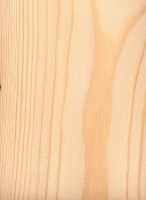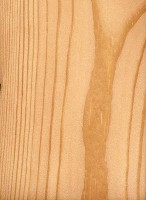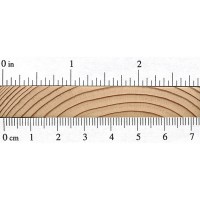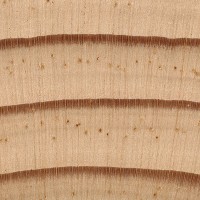 |
Common Name(s): Jack Pine
Scientific Name: Pinus banksiana Distribution: Canada and northern United States Tree Size: 50-80 ft (15-24 m) tall, 1-2 ft (.3-.6m) trunk diameter Average Dried Weight: 31 lbs/ft3 (500 kg/m3) Specific Gravity (Basic, 12% MC): .40, .50 Janka Hardness: 570 lbf (2,540 N) Modulus of Rupture: 9,900 lbf/in2 (68.3 MPa) Elastic Modulus: 1,350,000 lbf/in2 (9.31 GPa) Crushing Strength: 5,660 lbf/in2 (39.0 MPa) Shrinkage:Radial: 3.7%, Tangential: 6.6%, Volumetric: 10.3%, T/R Ratio: 1.8 |
Color/Appearance: Heartwood is orangish brown, wide sapwood is yellowish white.
Grain/Texture: Straight grained with a coarse to medium texture.
Endgrain: Medium-sized resin canals, numerous and evenly distributed, mostly solitary; earlywood to latewood transition abrupt, color contrast moderate to high; tracheid diameter medium.
Rot Resistance: The heartwood is rated as moderate to low in decay resistance.
Workability: Jack pine works well with both hand and machine tools. Glues and finishes well.
Odor: Jack Pine has a faint, resinous odor while being worked.
Allergies/Toxicity: Working with pine has been reported to cause allergic skin reactions and/or asthma-like symptoms in some people. See the articles Wood Allergies and Toxicity and Wood Dust Safety for more information.
Pricing/Availability: When sold as lumber, Jack Pine is mixed with other softwood species under various lumber grade groups; one common grouping consists of various species of spruce, pine, and fir and is stamped with the abbreviation “SPF.” In this form, Jack Pine should be widely available as construction lumber for a modest price.
Sustainability: This wood species is not listed in the CITES Appendices, and is reported by the IUCN as being a species of least concern.
Common Uses: Paper (pulpwood), boxes/crates, pallets, poles, and construction lumber.
Comments: Jack Pine lumber is generally rather knotty, and tends to be less desirable than other, clearer pine species within its range, such as Red Pine. Jack Pine is difficult to tell apart from some of the lighter yellow pines whose native ranges are farther west, such as Lodgepole Pine and Ponderosa Pine. Generally, dimpling on flatsawn surfaces will appear more subdued and less common in Jack Pine than in Lodgepole Pine.
Although Jack Pine is technically classified as a yellow (hard) pine, it shares many characteristics with white (soft) pines, having a considerably lower density than the yellow pine species found in the eastern United States.
- Austrian Pine (Pinus nigra)
- Caribbean Pine (Pinus caribaea)
- Eastern White Pine (Pinus strobus)
- Jeffrey Pine (Pinus jeffreyi)
- Khasi Pine (Pinus kesiya)
- Limber Pine (Pinus flexilis)
- Loblolly Pine (Pinus taeda)
- Lodgepole Pine (Pinus contorta)
- Longleaf Pine (Pinus palustris)
- Maritime Pine (Pinus pinaster)
- Ocote Pine (Pinus oocarpa)
- Patula Pine (Pinus patula)
- Pinyon Pine (Pinus edulis)
- Pitch Pine (Pinus rigida)
- Pond Pine (Pinus serotina)
- Ponderosa Pine (Pinus ponderosa)
- Radiata Pine (Pinus radiata)
- Red Pine (Pinus resinosa)
- Sand Pine (Pinus clausa)
- Scots Pine (Pinus sylvestris)
- Shortleaf Pine (Pinus echinata)
- Slash Pine (Pinus elliottii)
- Spruce Pine (Pinus glabra)
- Sugar Pine (Pinus lambertiana)
- Sumatran Pine (Pinus merkusii)
- Table Mountain Pine (Pinus pungens)
- Western White Pine (Pinus monticola)
- Virginia Pine (Pinus virginiana)
Scans/Pictures:
 |
 |
 |
 |


The Pinus bankisiana is one of my favourite wood and it’s very beautiful tree